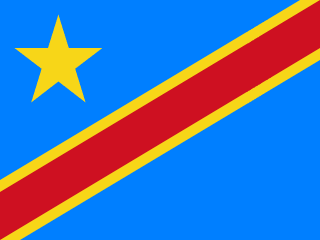DR Congo - Geography

Here, let us take a look at the Geography of DR Congo. note 1: second-largest country in Africa (after Algeria) and largest country in sub-Saharan Africa; straddles the equator; dense tropical rainforest in central river basin and eastern highlands; the narrow strip of land that controls the lower Congo River is the DRC's only outlet to the South Atlantic Ocean
note 2: the Congo River, most of which flows through the DRC, has never been accurately measured along much of its length because of its speed, cataracts, rapids, and turbulence; nonetheless, it is conceded to be the deepest river in the world, with estimates of the point of greatest depth varying between 220 and 250 meters. Mother's mean age at first birth is 19.9 years (2013/14 est.) (Note: data represents median age at first birth among women 20-49), whereas, the Maternal mortality ratio is 427 deaths/100,000 live births (2023 est.)
Geographical data of DR Congo
| Location | Central Africa, northeast of Angola |
|---|---|
| Geographic coordinates | 0 00 N, 25 00 E |
| Map references | Africa |
| Tarrain | vast central basin is a low-lying plateau; mountains in east |
| Natural Resources | cobalt, copper, niobium, tantalum, petroleum, industrial and gem diamonds, gold, silver, zinc, manganese, tin, uranium, coal, hydropower, timber |
| Natural Hazards | periodic droughts in south; Congo River floods (seasonal); active volcanoes in the east along the Great Rift Valley volcanism: the active volcano Nyiragongo (3,470 m) poses a major threat to the city of Goma, home to a quarter of a million people; it produces unusually fast-moving lava, known to travel up to 100 km/hr; Nyiragongo has been deemed a Decade Volcano by the International Association of Volcanology and Chemistry of the Earth's Interior, worthy of study due to its explosive history and close proximity to human populations; its neighbor Nyamuragira is Africa's most active volcano; Visoke is the only other historically active volcano |
| Irrigated Land | 110 sq km (2012) |
| Major rivers (by length in km) | Zaïre (Congo) river mouth (shared with Zambia [s], Angola, and Republic of Congo) - 2,920 km; Ubangi river mouth (shared with Central African Republic [s] and Republic of Congo) - 2,270 km note: [s] after country name indicates river source; [m] after country name indicates river mouth |
| Major aquifers | Congo Basin |
| Land Boundaries | 11,027 km |
| Border Countries | Angola 2,646 km (of which 225 km is the boundary of Angola's discontiguous Cabinda Province); Burundi 236 km; Central African Republic 1,747 km; Republic of the Congo 1,775 km; Rwanda 221 km; South Sudan 714 km; Tanzania 479 km; Uganda 877 km; Zambia 2,332 km |
| Coastline | 37 km |
| Climate | tropical; hot and humid in equatorial river basin; cooler and drier in southern highlands; cooler and wetter in eastern highlands; north of Equator - wet season (April to October), dry season (December to February); south of Equator - wet season (November to March), dry season (April to October) |
| Area | |
| Total Area | |
| Land Area | 2,267,048 sq km |
| Water Area | 77,810 sq km |
| comparative Area | slightly less than one-fourth the size of the US |
| Maritime Claims | |
| Territorial sea | 12 nm |
| Exclusive economic zone | since 2011, the DRC has had a Common Interest Zone agreement with Angola for the mutual development of off-shore resources |
| Elevations | |
| Highest point | Pic Marguerite on Mont Ngaliema (Mount Stanley) 5,110 m |
| Lowest point | Atlantic Ocean 0 m |
| Mean elevation | 726 m |
| Land Use | |
| Agricultural land | 15.5% (2023 est.) |
| Agricultural land: arable land | arable land: 6.6% (2023 est.) |
| Agricultural land: permanent crops | permanent crops: 0.9% (2023 est.) |
| Agricultural land: permanent pasture | permanent pasture: 8% (2023 est.) |
| Forest | 61.6% (2023 est.) |
| Other | 22.9% (2023 est.) |
Population Distribution
Urban clusters are spread throughout the country, particularly in the northeast along the border with Uganda, Rwanda, and Burundi; the largest city is the capital, Kinshasha, located in the west along the Congo River; the south is least densely populated, as shown in this population distribution map
People and Society
In DR Congo, the different Ethnic groups are such that we have: More than 200 African ethnic groups of which the majority are Bantu; the four largest groups - Mongo, Luba, Kongo (all Bantu), and the Mangbetu-Azande (Hamitic) - make up about 45% of the population
| Population | |
|---|---|
| Pop growth rate | 3.11% (2024 est.) |
| Birth rate | 39.2 births/1,000 population (2024 est.) |
| Death rate | 7.6 deaths/1,000 population (2024 est.) |
| Health expenditure | |
| Physicians Density | |
| Hospital bed Density | |
| Total fertility rate | 5.49 children born/woman (2024 est.) |
| Gross reproduction rate | 2.7 (2024 est.) |
| Contraceptive prevalence rate | |
| Est married women (ages 15-49) | 55.3% (2023 est.) |
| Literacy | |
| Education expenditures | |
| Net Migration rate | -0.6 migrant(s)/1,000 population (2024 est.) |
| Nationality | Congolese or Congo | Congolese (singular and plural) |
| Languages | |
| Religions | Christian 93/1% (Roman Catholic 29.9%, Protestant 26.7%, other Christian 36.5%), Kimbanguist 2.8%, Muslim 1.3%, other (includes syncretic sects and indigenous beliefs) 1.2%, none 1.3%, unspecified 0.2% (2014 est.) |
| Age Structure | |
| 0-14 years | 45.7% (male 26,584,268/female 26,208,891) |
| 15-64 years | 51.8% (male 29,845,450/female 29,884,958) |
| 65 years and over | 2.5% (2024 est.) (male 1,258,442/female 1,621,018) |
| Dependency Ratios | |
| Total dependency ratio | 93.2 (2024 est.) |
| Youth dependency ratio | 88.4 (2024 est.) |
| Elderly dependency ratio | 4.8 (2024 est.) |
| Potential support ratio | 20.7 (2024 est.) |
| Median Age | |
| Total | 16.9 years (2024 est.) |
| Male | 16.7 years |
| Female | 17 years |
| Urbanization | |
| Urban population | 47.4% of total population (2023) |
| Rate of urbanization | 4.33% annual rate of change (2020-25 est.) |
| Major urban areas (Pop) | 16.316 million KINSHASA (capital), 2.892 million Mbuji-Mayi, 2.812 million Lubumbashi, 1.664 million Kananga, 1.423 million Kisangani, 1.249 million Bukavu (2023). |
| Sex Ratio | |
| At birth | 1.03 male(s)/female |
| 0-14 years | 1.01 male(s)/female |
| 15-64 years | 1 male(s)/female |
| 65 years and over | 0.78 male(s)/female |
| Total population | 1 male(s)/female (2024 est.) |
| Infant Motality | |
| Total | 57.4 deaths/1,000 live births (2024 est.) |
| Male | 62.9 deaths/1,000 live births |
| Female | 51.9 deaths/1,000 live births |
| Life Expectancy at birth | |
| Total population | 62.6 years (2024 est.) |
| Male | 60.7 years |
| Female | 64.6 years |
| Drinking Water Sources | |
| Improved: urban | urban: 59.3% of population (2022 est.) |
| Improved: rural | rural: 13.8% of population (2022 est.) |
| Improved: total | total: 35.1% of population (2022 est.) |
| Unimproved: urban | urban: 40.7% of population (2022 est.) |
| Unimproved: rural | rural: 86.2% of population (2022 est.) |
| Unimproved: total | total: 64.9% of population (2022 est.) |
| Sanitation facility acess | |
| Improved: urban | urban: 48.8% of population (2022 est.) |
| Improved: rural | rural: 20.5% of population (2022 est.) |
| Improved: total | total: 33.7% of population (2022 est.) |
| Unimproved: urban | urban: 51.2% of population (2022 est.) |
| Unimproved: rural | rural: 79.5% of population (2022 est.) |
| Unimproved: total | total: 66.3% of population (2022 est.) |
| Alcohol consumption per capita | |
| Total | 0.56 liters of pure alcohol (2019 est.) |
| Beer | 0.5 liters of pure alcohol (2019 est.) |
| Wine | 0.01 liters of pure alcohol (2019 est.) |
| Spirits | 0.05 liters of pure alcohol (2019 est.) |
| Other alcohols | 0 liters of pure alcohol (2019 est.) |
| Tobacco use | |
| Total | 10.4% (2025 est.) |
| Male | 18.8% (2025 est.) |
| Female | 2.3% (2025 est.) |
| Child marriage | |
| Women married by age 15 | 8.4% (2018) |
| Women married by age 18 | 29.1% (2018) |
| Men married by age 18 | 5.6% (2018) |
Demographic profile
All Important Facts about DR Congo
Want to know more about DR Congo? Check all different factbooks for DR Congo below.









